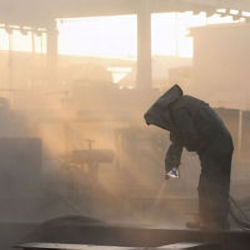About Respiratory Hazards
Respiratory hazards include harmful substances and below-normal concentrations of oxygen in the air we breathe.

What makes a substance harmful depends on its toxicity, chemical state, physical form, concentration, and the period of time one is exposed. Examples include:
- particulates,
- gases and vapors, and
- biological organisms.
Harmful effects are wide ranging and may occur immediately (acute) or take years to develop (chronic).
Particulates: These are airborne particles such as dust, fibers, fumes, mists, soot, and smoke. Some are so small they can only be seen with an electron microscope. The diameter of a particulate is usually measured in micrometers (one micrometer equals 1/1,000 millimeter or 1/25,400 inch). Particles with diameters under 10 micrometers are more likely to enter the respiratory system.
Gas and vapors: Gases can spread freely in the air. Vapors are the gaseous states of substances that are liquids or solids at room temperature. Gases and vapors are classified by their chemical forms.
Biological organisms: These include bacteria, viruses, fungi, and other living organisms that can cause respiratory infections.
Oxygen-deficient atmosphere: Normal air has an oxygen concentration of 20.8 percent by volume. When the concentration drops below 19.5 percent, the air is oxygen deficient and considered immediately dangerous to life and health (IDLH). The harmful effects of oxygen deficiency include impaired thinking and coordination, unconsciousness, and death.
Knowledge Check Choose the best answer for the question.
1-1. Dusts, fibers, fumes, mists, soot, and smoke are all examples of _____.
You forgot to answer the question!
